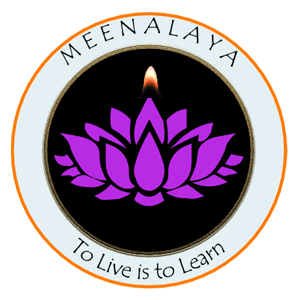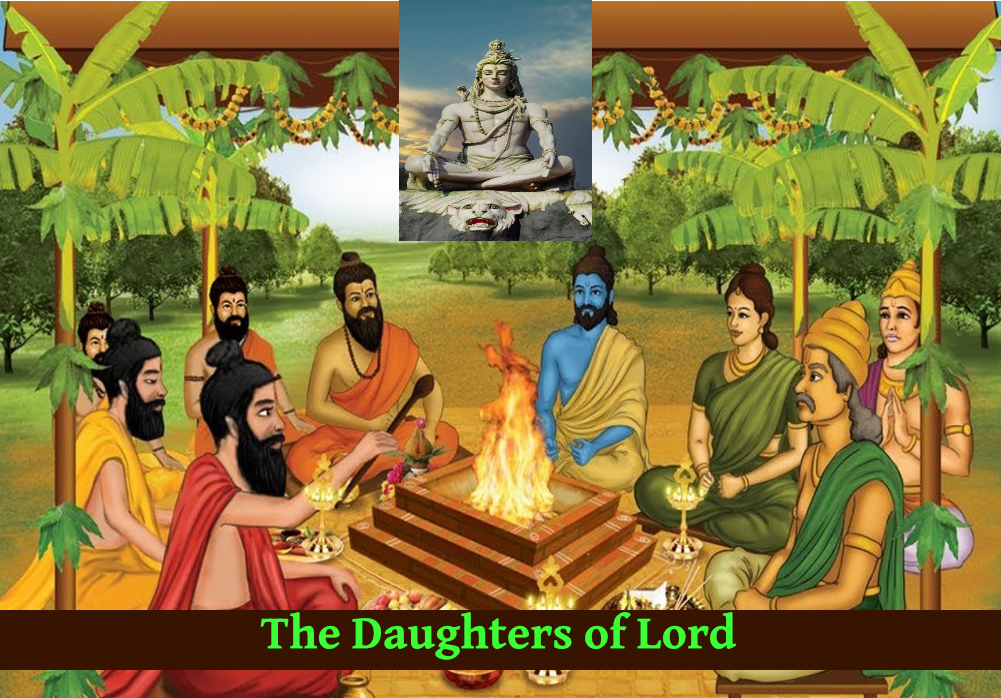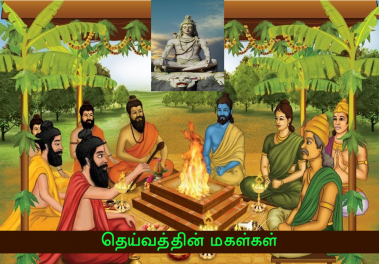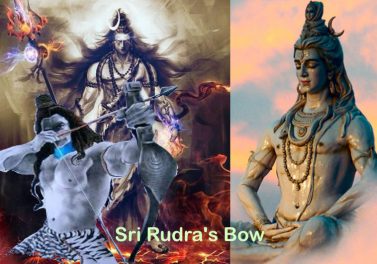The Daughters of Lord
Conversation With Aiya (33)
“You seem to be worried”, Aiya asked me while gently tapping on my shoulder.
It was, as ever, a pleasure to see him.
“No Aiya, not worried. Just thinking about something which needs some resolution. Now you are here, I am relieved.”
Aiya laughed!
“What is the crime that you have committed this time!”
I smiled. “Hope it is not a crime. Just a doubt that lingers in my mind since Sunday, after we have performed the Mahā Rudra Japa Yajnam.”
“Yes, I briefly saw the live-stream! Very nice to see such a thing happening in the UK. That too, seeing young children, including little girls reciting Sri Rudram.”
I always have the feeling that Aiya could read my mind. ‘Is he doing it now’, I pondered!
“Aiya, that is exactly what had triggered a bit of a concern in me, to search for an answer.”
I hastened.
“When one or two learned people deem the voluntary recitation of Sri Rudram by a few devoted ladies and young girls as a ‘pāpam’, then is not a cause for concern?”
Aiya laughed!
“Pāpam? mmm …. that is a big word! Mind you, in every action that is done with a motive, there is a consequential potential for both ‘Punyam’ and ‘Pāpam’. If one decides to look at the risk of ‘pāpam’, so be it! What is your concern?”
“Aiya! I know there is lot of debates on the topic, and even great achāryās assert different views. My question is this: Are women not qualified to recite Vēda-mantras? Particularly Sri Rudram?”
“Although I know of no such assertion in the Śruti, there are clear injunctions in various Smr̥tis and Purāṇa that prohibit women from learning the Vēda. You may have heard from many āchāryas quoting Bhagavān Bādarāyaṇa:
strīśūdradvijabandhūnāṁ trayī na śrutigōcarā |
karmaśrēyasi mūḍhānāṁ śrēya ēvaṁ bhavēdiha |
iti bhāratamākhyānaṁ kr̥payā muninā kr̥tam ||”
Aiya continued.
“These injunctions are all in Smr̥tis, which therefore could change and need to change.”
“Aiya, but then is not a conflict?”
“Well, there are many women mentioned in the Śruti and revered as Brahmavādinīs such as Lōpāmudrā, Vāk, Śraddhā, Yamī, etc. who were not only the scholars of Vēdas but also the preceptors giving greater elucidations to the import of Vēdas.”
“But then are there not the prerequisite such as the Upanayana and the initiation of Brahmacharya-āśrama to qualify for the recitation of Vēda and doing Vēdādhyana?”
“Yes! So, we could only conclude that in those days, these prerequisites might have been applicable to all – both men and women! And there are many evidences for this.”
“Aiya, I thought ‘Upanayanam’ only applies to those who are born as Brāhamin?”
Aiya, rising his wide eye-brows, said:
“Born as Brāhamin…! No, to be a Brāhamin is not the birth-right. It is an acquired title, coming from the way-of-life one chooses. Consider the event, ‘Upanayanam’ as the ceremonial point of departure, that was available for everyone, to pursue a life-style of choice and societal needs, and by taking a divine vow or ‘sankalpam’. In the Vēdic times, this ritual was common to all, and upon which, one could follow one of the three paths: a life of learning and propagating Vēdic knowledge to all, or a life of absolute personal sacrifice for the protection of others or a life that is committed for creating and exchanging wealth for the benefit of all. These three chosen approaches were known as the three varna, viz, Brāhamana, Kshatriya and Vysya, each bound by the clear division of labour and also a set of pertaining strict code of conduct. All others, remain as ‘Shudra’, our default state, and this fourth Varna did not have any rigorous code of conduct exposed except for the obligation to help other three Varnas. So ‘Upanayanam’ was once a common ritual.”
“Was there a hierarchy among these Varna? It is still being criticised as a deliberate abuse and negative discrimination.”
“In Vēdic times, there was no hierarchy among these Varnas and I agree with you on how such classification had caused undue fights based on caste and unacceptable societal disharmony! No, such views are incorrect.”
Aiya continued.
“But in terms of enjoying the worldly pleasures, perhaps, the Brāhamins have to adhere to maximum restrictions as they were required to lead a very simple life and to remain as the foremost example to others for dharma or the righteousness. The Kshatriyā, who sacrifice their life for the protection of others had the highest privilege, followed by the Vysya, for enjoying the worldly comforts. The Shudras, although work for all others, have no restrictions in the pursuit of worldly pleasures, so you can see the freedom of choice and the associated conditions.”
“So, it was once a question of life-style and life-pursuits and not by birth, correct?”
“Yes! The three, Brāhmana, Kshatriya and Vysya – all had the right to study Vēdas and evidence suggest that all have studied. Of course, as human life is of short duration, and the knowledge contained in the Vēdas are vast, each Varna chose to study only those part of Vēdas that are essential for their life-style and life-pursuits.”
“What are those?”
“Well, the righteous means of leading a happy life here and here-in-after is the primary goal for anyone. Vēdas provided the three goals namely Dharma, Artha and Kāma, as to be attained by actions by our body, ‘sarira’. That is why the primary, and a large part of Vēdas, known as Vēda-Purva deal with actions to be performed by according to the type of embodiment. That is why the elucidation of Vēda Purva is known as ‘Sāriraka Bhāsyam’, do you follow?”
“Yes Aiya, but my question is, what does it got do about women reciting the Vēdas?”
“Everything! Bodily pursuits mean, there is a differentiating need to match the type of bodies and their state of transition. Between men and women, some are strong and some are weak, in some or other respects. That is why the rites and austerities were suitably mapped to who could do what! Of course, such guidelines have turned into injunctions in practice so that the division of labour is unambiguous. Men and women, and among them, of different Varnas had clear and distinct paths to tread in their life pursuits.”
“Aiya, that might be! But these are not relevant in modern times.”
“Absolutely! That is why the Smr̥tis always undergo change and thus be able to remain eternally fresh. That is why ours is called ‘Sanātana Dharma’. Ours is not dogmatic but pragmatic approach to life.”
“Yes Aiya! But we still have rules that may not fit the modern times.”
“Yes! In rituals, such conditions still linger and we need to respectfully inquire and resolve. But in spiritual path, there are no such conditions.”
“I don’t understand Aiya.”
“Well, these days, there is no Varna or classification of strict life-styles possible. As we reject the birth-based rights of Varna dharma, we may mistakenly conclude that all that is related to Varna Dharma is lost. No! if you notice carefully, each of us exhibit all the four traits of the Varnas in our life-pursuits. When we seek lofty ideals about the Self and strive to seek divinity in all, we are Brāhamin. When we defend righteousness and prepare to protect others even at the cost of our own possessions and life, we are Kshatriya. When we work to create and transact wealth for the benefit of one and all, we are Vysya. When we toil in our jobs and in servitude to others, we are Shudra. We therefore still need to inculcate the Vēdic Dharma, not because we are born in a particular family or caste, but because we are pursuing certain righteous goals and path. Vēdas are relevant and applicable to all at all times.”
“How is it so, Aiya? All those rituals, beliefs, karmas – how could these be applicable to all those who are not Hindus? How could someone born in some distant land deem Vēdas as the guide? Especially, many of the Vēdic rituals are totally alien to the heritage and culture of others, how could therefore Vēdas be universal?”
“That is a great question. While Vēdic rituals only resonate as reasonable for the Hindus, that too for only a subset in these days, how could we claim Vēdas as Universal knowledge!”
Aiya repeated my question, and then continued to answer.
“Vēda is like a huge forest Vedāranya, and infinite in its scope. The divine sounds of Vēda were only heard by the Seers of the holy land of Bharath, who were meditating upon the truth, and subsequently through their expression of sound, propagated the Vēdas as the Śruti. That is why, Vēda Purva is heard and catalogued to suit their land of living and their living conditions. So, I grant that the vast portion of Vēda Purva is not readily applicable to those who are not born or inherited the way of living in Bharath. But Vēdānta, the last or the core part of Vēdas is not about the ‘Sariram’ but about the ‘Atma’, the sentient principle of all things. The Atma is what makes the inert body to act, enjoy or suffer. Only upon ‘Atma’, the effulgence of pure Awareness, is the cause of all objectification of the world. May you know that the Atma is indivisible, infinite, unattached, eternal, all pervading, and all indwelling Truth. That is why Vēdānta is applicable to all and so, universal. It is not any ‘Indian’ or ‘Hindu’ book. It is the revelation of the ‘absolute’ for the entire humanity. Everyone has the right as well as the duty to study. This human birth will be a missed opportunity if one does not study and contemplate on the import of Vēdānta. That is why Vēdas are said as Universal.”
“Aiya, then why do we bother about all the rituals of Vēda Purva? Why can’t we go straight to what matters, the Atma-Jnāna or the wisdom of the Self that are contained in the Vēdānta?”
“Well, you could do, when the Universities start admitting illiterates to the PhD programs just because the illiterates desire the ultimate research degree.”
“No Aiya, that is not possible, one must acquire basic education and also develop a keen interest and focus on the topic of research to go to the PhD.”
“Exactly! That is why doing the assumed and assigned karmas are the important steps. Choose a life style that fits your character, conditions and the opportunities. Follow the chosen life style with relevant actions that are righteous. Seek security, earn riches that make you enjoy the world, then watch how those hard-earned riches and relatives ultimately dissipate and cause distress! Notice the futility of worldly pleasures and the temporal nature of body. Ask the question about what is next, and next and next! There comes a thirst of the truth. Then comes Vēdānta, to anyone and to everyone!”
“Aiya, is Sri Rudram Vēdanta?”
“Technically, as Sri Rudram is recited as mantras for offering oblation to the Lord, mainly in search of material benefits and to ward off grief, all relating to the embodied life, in this world and here-in-after, we can say, Sri Rudram is part of Vēda Purva. Therefore, all conditions of its recitation must be met, as the goal is worldly pleasures. In other words, when Sri Rudram, or for that matter, any ritual is done to acquire ‘Punyam’, the prepaid card for future pleasures, then, yes, Sri Rudram is part of Vēda Purva. It is a Karma. It is dhravya-yajna where material wealth is offered as oblation in sacrifices and material pleasures are sought as the benefit. If one is reciting Sri Rudram for ‘Punyam’, which is a ‘Karma-phalam’, then how the Karma is done is the sole criteria for the return on investment. Following all the prescribed rituals – be it the way one dresses, one chants, one seeks the services of the Achārya – all that matter. Ishvara is then only the custodian and guarantor of returning the favour as Karma-phalam.”
“Is there another perspective?”
“Yes, if Sri Rudram is recited and the Yajna is performed for no selfish reason, but for the well-being of all, then there is an implicit sacrifice of the Karma-Phalam also. There things are different.”
“Sacrifice the Karma-Phalam? That means giving up the Punya too?”, I asked earnestly.
“Yes, Punya brings pleasure and happiness in embodied life. But it does not last, which therefore leads to anxiety and grief. Of course, as you know Pāpam causes grief. So together, they all lead only to the cycle of temporal pleasures and pain. We can give those two eventually.”
“Then what is the point?”
“The point is the mind, that vacillates becomes still. It becomes pure. It attains steadfast focus. Like a mirror without blemish, the mind reflects the truth that is within. The Self is revealed.”
“Aiya, are you saying just by doing the rituals without selfish reasons, the self is revealed?”
“Yes and no.”
Aiya continued after a brief pause.
“Yes, because it is like the undergraduate course that is needed to do post graduate course. In that sense, self-less action that sacrifices the very benefit of the action is the foremost qualification for the seeker. Then the seeker’s mind becomes the right container to receive the Truth.”
“Why then you also said No!”
“No because, the pure mind although necessary, is not sufficient. The mind has to inquire the nature of the Self. Atma-vicāram is needed as the result of inquiry is the salvation. Jnānam alone reveals the Self.”
“Why/”
“It is because, ignorance alone causes the misperception of the Self and everything.”
“Like what?”
“Like thinking that I am the body. Thinking that the objective world is eternal. Thinking that I have a beginning and an end.”
“Aiya, Don’t I end with my death? Have I not had the beginning from the birth?”
“No, those beginning and the end are only the terminal points of your association with this body. It is a leasing arrangement between you and the body that terminates.”
“What do you mean by you… The Self?”
“Just say the Jiva, which is sustained on the Self!”
“Who is the Jiva?”
“Jiva is the bundle of body and mind. When disembodied, Jiva is just the Mind. Like the body is inert, know that the mind is also inert. But the mind being so subtle compared to the gross body, as any finer object has more reflectivity, it is able to reflect the indwelling Self or Atma very well and so the mind itself looks like naturally sentient.”
“So, what happens when the tenancy ends for the Mind?”
“It leaves the body and goes on to find another one. That astral search is propelled by the desires that the mind carries as the fragrance of karma-phalam or vāsana. Accordingly, it takes another birth and another life… This cycle continued for Jiva and it is thus said to be in Samsara.
“So Self is just there!”
“Self is there always! Self alone is there! When the Jiva realizes that he is neither the gross body, nor the subtle mind or its faculties, not even the accumulated karma-phalam but the ever effulgent Atma, then the Jiva gains ‘Atma-Bodham’. That luminance removes the veil of ‘Jiva-Bhāvam’ that the Jiva carried all along, then there is liberation.”
“Aiya, coming back to the recitation of Sri Rudram…”, I traced back to my doubt.
“Yes! The wonderful seers of Sanātana Dharma have planted the keys for divine inquiry, not only in the esoteric Vēdic Texts but also in ordinary verses of prayers. We only have to look for the keys and take those for contemplation. Sri Rudram is called Rudropanishad, as that which reveals the Self, for those who identify the keys of revelations, that are buried in the Shabdha (by hearing) and the Artha (by inquiring the meaning). Then the ritual becomes a profound Atma-vicāram. The Dhravya-Yajnam becomes the Jnāna-Yajnam. When such Jnāna-Yajnam is the goal, where is the question of discrimination? Where is the question of man or woman? Are not the Shraddha and Bhakti the main ingredients? Is not Vairāgya, the dispassion towards all that take away from the Truth, the main qualification?”
I was sitting calmly as my anxiety has subsided.
Aiya continued.
“OK, now do you still want to argue about the sanctity or not of women reciting Sri Rudram?”
“No Aiya, when someone said that we cause Pāpam by letting the woman-folks to join and recite Sri Rudram, I was concerned!”
“Don’t be! Pāpam and Punyam are only for those who are after the material pleasures! For those who seek peace and fulfilment, and pray for the welfare of the world, these pair of opposites are unnecessary!”
“Aiya, then if one recites only for the goal of Atma -Jnānam, does one get freedom from the ills of life!”
“Don’t worry! Pursuit of Atma -Jnānam is built only on absolute sacrifice. Again, sacrifice is not an action, as if you give up something that you own to others! That is egoity. Sacrifice is the result of total surrender. As everything belongs to Ishvara, when you surrender to Ishvara, there is nothing left for you to make further sacrifices. Then the so-called life of yours is in the custody of Ishvara. Then there is nothing to be afraid of! Come what may, you will have the capacity to cope and excel.”
I smiled.
“Don’t worry”, said Aiya.
“I don’t”, saying thus, I bid farewell to Aiya!
Mee. Rajagopalan
8 May 2023




